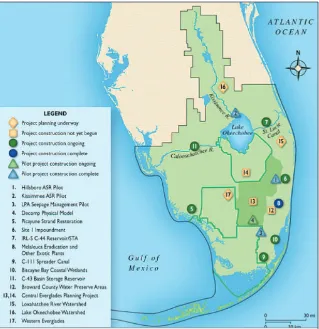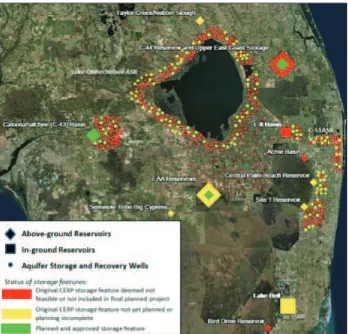Repor t
HigHligHts
Progress Toward Restoring the Everglades
the sixth Biennial Review—2016
Measurable ecosystem improvements are beginning to be realized from completed components of the Comprehensive Everglades Restoration Plan (CERP), and major ecosystem improvements are within reach as three non-CERP restoration projects near completion. However, new knowledge about the Everglades’ pre-drainage hydrology, climate change and sea level rise, and the feasibility of storage alternatives has substantial impacts on the expected outcomes of restoration efforts. Forward-looking analysis, in conjunction with program-level adaptive manage-ment, is needed to inform decision-making and ensure that the CERP is based on the latest scientiic and engineering knowledge and is robust to changing conditions.
C
onsidered a national treasure, the Florida Everglades is a diverse and geographically extensive wetland ecosystem reaching from lake Okeechobee to Florida Bay. After nearly 150 years of drain-age, channelization, and lood control actions, the Everglades has been dramatically altered. Now half its original size, the remnants of the Everglades compete for water with urban and agricultural interests and are impaired by contaminated runoff from these two activities.the U.s. Congress authorized the Comprehensive Everglades Restoration Plan (CERP) in 2000 to help reverse the Everglades’ decline. the $16.4 billion project was originally envisioned as a 30- to 40-year effort to reestablish the natural hydrologic characteristics in the south Florida ecosystem, where feasible, and to create a water system that serves the needs of both the natural and the human systems. the restoration program is the largest in U.s. history and is jointly administered by the U.s. Army Corps of Engineers (UsACE) and the south Florida Water Management District (sFWMD) and equally funded by the federal government and the state of Florida.
this report is the sixth in a series of congressionally mandated biennial reviews by the National Academies of sciences, Engineering, and Medicine to assess restoration progress and identify policy, scientiic, or other relevant issues that may impede or diminish the overall success of the CERP.
Vegetation growth is
one of the measurable
improvements attributable
to restoration eforts.
spending for the CERP caused by the state-federal cost-sharing requirements. Nonetheless, the funding pace remains slower and the project costs greater than origi-nally envisioned, leading to the prospect that program completion will extend beyond 2060. given that only 16 to 18 percent of the estimated total CERP cost has been funded, substantial additional investment will be needed to complete the project as envisioned.
IMPLICATIONS OF NEW KNOWLEDGE ON
THE CERP
since the CERP was developed, the scientiic community has gained substantial new knowledge on pre-drainage hydrology, climate change, and sea-level rise that have important implications for the restoration plan.
Although program managers recognized from the start that the former Everglades cannot be recre-ated, they appropriately focused on “getting the water right” by mimicking historic hydrologic conditions as much as possible. However, recent work indicates that the Everglades ecosystem was historically much wetter than previously thought. As a result, recreating historic hydrology would have different ecological outcomes and necessitate more new water than originally envi-sioned in the CERP.
IMPLEMENTATION PROGRESS
sixteen years into the CERP, several project components are completed or nearing completion and are beginning to yield measurable results, especially in terms of creating hydrologic condi-tions increasingly similar to pre-drainage lows. For example, portions of Picayune strand are experiencing higher water levels even though the project is not yet complete, and vegetation is becoming more similar to reference conditions. the documented hydrologic improvements from the early CERP projects imple-mented involve a small proportion of the overall CERP footprint and are located on the periphery of the remnant Everglades.
However, major system-wide res-toration beneits--for example, further rehydrating wetlands to improve habitat conditions—are within reach as two more CERP projects are nearing completion, four more are ongoing (see Figure 1), and three major non-CERP projects with large-scale restoration beneits—the Modiied Water Deliveries (Mod Waters), C-111 south Dade, and Kissimmee River Restoration projects—are anticipated to be completed in the next 5 years. Additionally, the large-scale Central
Everglades restoration project was recently authorized by Congress.
Non-CERP efforts to enhance the management and operations of stormwater treatment areas (stAs) continue to improve water quality in the remnant Everglades. in water year 2015, the average phosphorus concentration over all stA outlows was 17 ppb, the low-est achieved over 21 years of operation. Although the target annual concentrations necessary for moving new water into the Everglades through the CERP (13 ppb) have not yet been achieved, some stAs are approaching that goal. However, phosphorus concentrations in lake Okeechobee are double what they were in the early 1990s, despite projects aimed at reducing phosphorus export from agricultural activities. Outlows from the lake continue to contribute nutrient pollution to the estuaries, as evidenced by the algal blooms of 2016, and make it more dificult to reach CERP restoration goals for those areas.
the Everglades restoration funding outlook to sup-port project implementation has improved modestly over the past 2 years from an all-time low in 2012. Recent project authorizations and a more stable source of state funds have alleviated constraints on federal
sea level rise will reduce the footprint of the system, evapo-rative water losses are expected to increase, rainfall may become more variable, and more storage would likely be needed to accom-modate future changes in the quantity and intensity of runoff.
New calculations of water storage based on design changes, new understanding of project feasibility, and changes to lake Okeechobee’s operating rules indicate that surface water stor-age capacity could fall short of that originally envisioned in the CERP by more than 1 million acre feet (see Figure 2). Additionally, estimated feasible underground storage has been reduced by approximately 60 percent, reduc-ing the beneits provided by the CERP in multi-year droughts. Reduced water storage could have serious ecological conse-quences in both the northern estuaries and the Everglades ecosystem if this shortfall is not addressed.
the scientiic uncertain-ties related to climate change
and water storage should not be ignored but rather incorporated into CERP planning. A systemwide screen-ing analysis of feasible, yet-to-be-implemented CERP storage alternatives is needed to evaluate modeled res-toration outcomes with various levels of storage. Even modest changes in the lake Okeechobee operations can have a large impact, suggesting that the lake is a central factor in future considerations of water storage. therefore, the process to revise lake Okeechobee oper-ations should be initiated as soon as possible to inform near-term project planning involving water storage north and south of the lake.
RECOMMENDED FORWARD-LOOKING
ACTIONS
When the CERP was launched in 2000, adaptive manage-ment was embraced as a means of incorporating new information into the plan and addressing unforeseen issues related to the plan. since that time, a framework for CERP adaptive management has been developed, and a structure for implementation at a project-level adopted, but the original vision of adaptive manage-ment at the program level remains unfulilled.
the CERP has made progress by developing the Program-level Adaptive Management Plan, which identiies critical uncertainties affecting restoration progress. the plan asks highly relevant questions about CERP-related storage, design and implementation, and climate change, many of which can and should be addressed now through new research and modeling in addition to ongoing monitoring. However, no actions have been taken to carry out the plan. Doing so would require an implementation strategy to address the high-est priority uncertainties and identify tasks, timelines, resources, and stafing needs.
Copyright 2016 by the National Academy of Sciences. All rights reserved. Copyright 2016 by the National Academy of Sciences. All rights reserved.
Division on Earth and life studies goals that capture knowledge gained since the CERP
was launched.
Finally, a systemwide analysis of the potential future state of the Everglades ecosystem, with and without future CERP restoration projects, particularly those with uncertain feasibility, needs to be conducted in conjunction with a CERP Update, which is long over-due. the CERP Programmatic Regulations requires a CERP Update—“an evaluation of the restoration plan using new or updated modeling that includes the lat-est scientiic, technical, and planning information”—be conducted at least every 5 years. However these have not been routinely conducted. this analysis also should consider various scenarios for climate changes and sea-level rise and explore the ecosystem implications of
various options for future CERP implementation, all of which should be help inform decision makers about the implications of near-and long-term decisions. the report states that such analyses should not slow the pace of restoration progress and that implementation of autho-rized projects should continue.
Challenges identiied by this analysis may illumi-nate the need for modiications, either in future project planning or in the restoration objectives and goals them-selves. Although some might consider that illuminating such issues makes complex stakeholder interaction even more dificult, failing to confront these problems in a science-based, objective manner can lead to even less desirable circumstances, including unrealistic expecta-tions, litigation, and reduced support.
COMMITTEE ON INDEPENDENT SCIENTIFIC REVIEW OF EVERGLADES RESTORATION
PROGRESS
David B. Ashley (Chair), University of southern California; Mary Jane Angelo, University of Florida, gainesville; William G. Boggess, Oregon state University, Corvallis; Charles T. Driscoll, syracuse University, New York; M. Siobhan Fennessy, Kenyon College, gambier, OH; William L. Graf, University of south Carolina, Columbia; Karl E. Havens, University of Florida, gainesville; Wayne C. Huber, Oregon state University, Corvallis; Fernando R. Miralles-Wilhelm, University of Maryland, College Park; David H. Moreau, University of North Carolina, Chapel Hill; Gordon H. Orians, University of Washington, seattle; Denise J. Reed, the Water institute of the gulf, Baton Rouge, lA; James E. Saiers, Yale University, Ct; Jefrey R. Walters, Virginia Polytechnic institute and state University, Blacksburg; Stephanie E. Johnson (Study Director, Water Science and Technology Board [WSTB]), David J. Policansky (Scholar, Board on Environmental Studies and Toxicology), Ed Dunne (Program Oficer, WSTB), Brendan R. McGovern (Senior Program Assistant, WSTB), National Academies of sciences, Engineering, and Medicine.
For More Information . . . this Report Highlights was prepared by the Water science and technology Board and the Board on Environmental studies and toxicology based on the report Progress Toward Restoring the Everglades: The Sixth Biennial Review—2016. the study was sponsored by the Department of the Army; support was also provided by the Department of the interior and the south Florida Water Management District. Any opinions, indings, conclu-sions, or recommendations expressed in this publication are those of the authoring committee and do not necessarily relect those of the sponsor. Copies of the report are available from the National Academies Press, (800) 624-6242;

